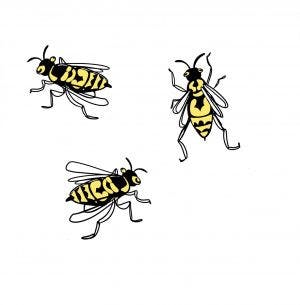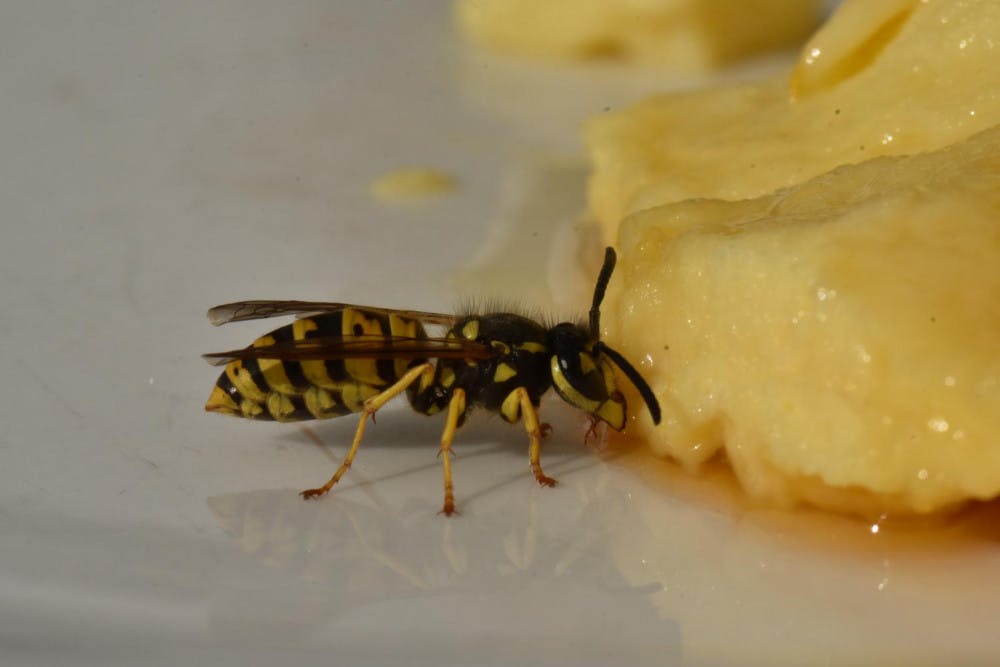“How crazy would it be if a bee flew into your mouth while you were eating?” Charlie Reinkemeyer ’21.5 asked his friends over breakfast outside Proctor.
When Reinkemeyer stood up with a yelp and announced that he’d just been stung, his friends thought he was joking. But the wasp that had alighted on the piece of fruit he was eating, dodging his gnashing jaws to jab the soft flesh on the inside of his cheek, was deadly serious.
Reinkemeyer is one of the latest in a long line of the wasps’ victims. Each fall, returning students are greeted by swarms of the black and yellow bugs outside of the dining halls descending on anyone who dares to eat outside. The picnic tables buzz with students complaining about the insects’ presence, debating whether they are bees or wasps and speculating as to why the college isn’t doing more to deal with them.
The Campus reached out to Middlebury’s bug experts for answers.

The bugs that swarm the dining halls are primarily yellowjacket wasps, easily identifiable by their thin waist, which allows them to swing their abdomen forward and sting in front of their bodies as well as behind, an important defensive feature, according to Assistant Professor of Biology Greg Pask, who studies insect neurobiology.
Yellowjackets can sting multiple times, unlike bees. However, each sting comes with a high energy cost, so wasps tend to reserve their venom for defensive purposes. Grabbing or swatting yellowjackets are good ways to get stung — as is being unlucky enough to trap one between your skin and clothes, or in your mouth.
Yellowjackets are especially territorial when it comes to protecting their nests. They sense approaching threats both by vibrations and by smelling exhaled carbon dioxide. A careful person can approach a wasp nest and study it at close range without getting attacked, as long as they hold their breath.
Only female wasps have stingers, which are actually primarily egg-laying tubes through which they can inject venom when needed. The venom includes a pain-inducing neurotransmitter called acetylcholine that “activates pain neurons in the skin,” Pask said in an email to The Campus. A variety of other proteins cause the severe inflammation that follows.
Entomologist Justin Schmidt let himself be stung by more than 80 varieties of insects to rate them on a pain scale in his book “The Sting of the Wild.” He gave the yellowjacket sting a two out of four, the same as most bee varieties, and described it as producing an “instantaneous, hot, burning, complex pain” that “lasts unabated for about two minutes, after which it decreases gradually over the next couple of minutes, leaving us with a hot, red, enduring flare to remind us of the event in case our memory should fade.”
While yellowjacket wasps may bug Middlebury students, they are popular with local farmers. They prey on bugs like biting flies, caterpillars and other pests that plague crops and gardens. Though not to the same degree as bees, they do occasionally drink nectar and pollinate plants as well.
Worker wasps bring the protein back to their nests and feed it to the larvae. The larvae consume the insects’ flesh, digest it and secrete a sugary substance that the adult wasps then eat.
This time of year, when the summer is ending and the wasps’ natural food sources are diminishing, sweet treats from the dining hall are extra appealing. Yellowjacket wasps have a keen sense of smell, and their antennae are covered with powerful scent receptors similar to nostril hairs. Yellowjackets are social insects and will communicate the location of food to their nest-mates by transferring the odor cue to their antenna. Then they will search out the source of the odor together, which often brings them to the dining halls on warm days when hundreds of students bring their meals outside.
Pask said the wasp swarms on campus are likely to worsen for future generations of students. With climate change extending the summer season, the wasps will hang around longer and multiply even more fruitfully. If conditions are good, a queen can lay 50 eggs a day, and a mature nest can host anywhere between 2,000 to 4,000 wasps.
Facilities staff try to remove wasps when they are a nuisance, like the yellowjackets that populate the area outside the dining halls, but there’s not much they can do if they can’t find their nests. Yellowjackets can forage as far as a mile from their nests.
They are primarily ground nesters, and their colonies can often be found at the base of trees, under porches or even in cracks in the sidewalks. They also seek out spaces between walls, and college horticulturalist Tim Parsons said he removed one nest from between the two window panes of one unfortunate student’s dorm room.
Depending on the year, the landscape team might remove anywhere between 10 and 30 bee and wasp nests a week, often by suctioning them out with a shop vacuum. This year, though, they are struggling. Over-enrollment is stretching their already-limited resources even thinner.
The landscape team is severely understaffed. They’re missing one out of their standard roster of 14, and they were only able to hire one out of the normal five seasonal workers they bring on for the busy fall time. They are now examining options to contract out wasp removal to relieve the burden on the limited workers, according to Parsons.
Wasp season should end in the next few weeks, before the time of the first frost. Before they die, the male wasps — “flying sperm packets” with little use beyond reproduction, according to Pask — will mate with future queens. The fertilized females will fatten up to “hibernate” over the winter before leaving the nest to form their own colonies next spring.
In the meantime, Parsons said it's best to “leave them be, no pun intended,” and hope you don’t have Reinkemeyer’s extraordinary bad luck.
Since his unfortunate experience, Reinkemeyer has taken to eating his meals indoors. If the weather is particularly nice, he might be tempted to brave the wasps and eat outside. But he’ll be carefully inspecting any food he puts in his mouth from now on.
Correction: A previous version of this article contained the wrong credit for the drawing of the wasps. The artist is Pia Contreras.

Sophia McDermott-Hughes ’23.5 (they/them) is an editor at large.
They previously served as a news editor and senior news writer.
McDermott-Hughes is a joint Arabic and anthropology and Arabic major.
Over the summer, they worked as a general assignment reporter at Morocco World News, the main English-language paper in Morocco.
In the summer of 2021 they reported for statewide digital newspaper VTDigger, focusing on issues relating to migrant workers and immigration.
In 2018 and 2019, McDermott-Hughes worked as a reporter on the Since Parkland Project, a partnership with the Trace and the Miami Herald, which chronicled the lives of the more than 1,200 children killed by gun violence in the United States in the year since the Marjory Stoneman Douglas High School shooting in Florida.




